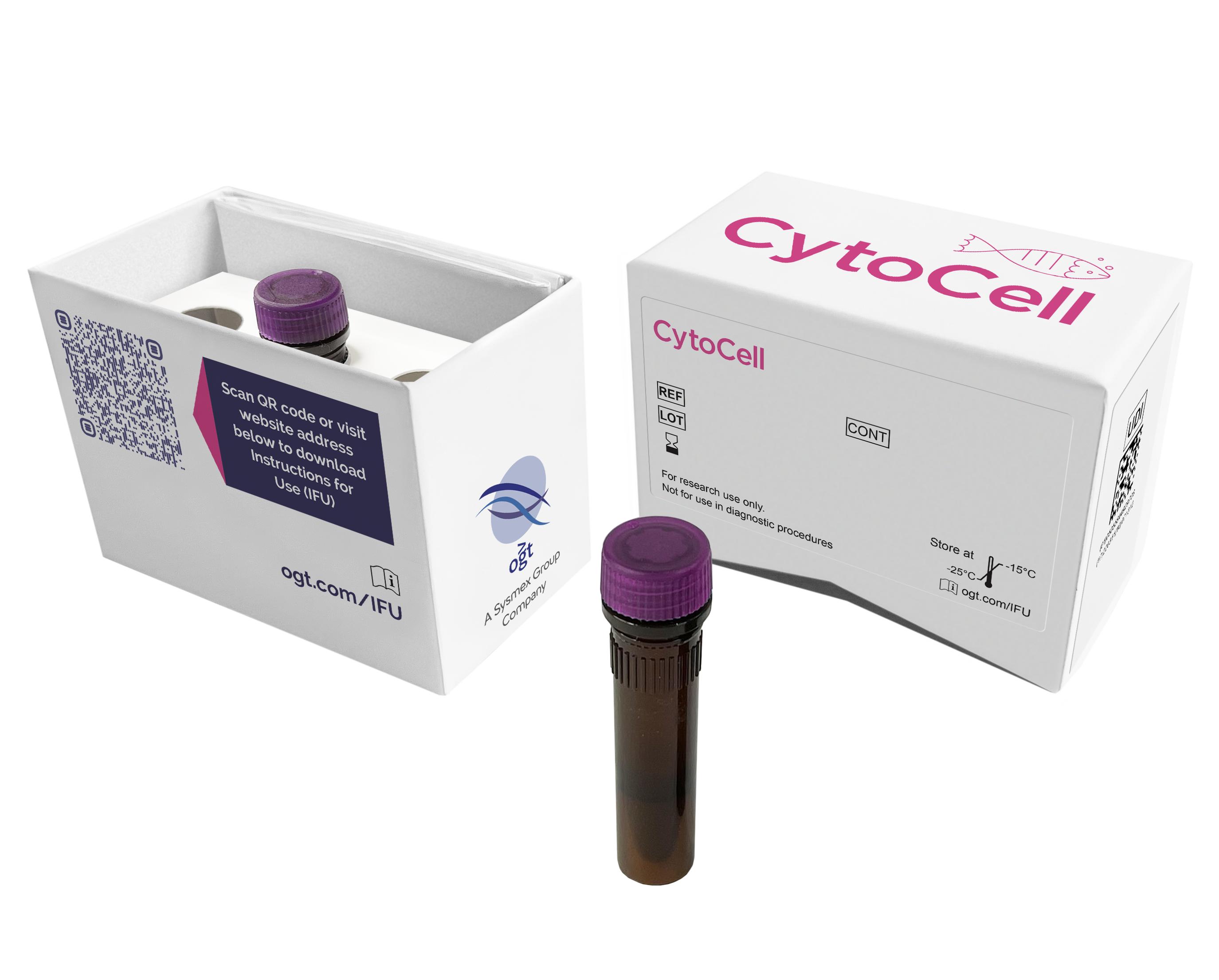
The BCL2 product consists of two green 161kb, 196kb probes and two red 304kb, 176kb probes, which are positioned on each side of the BCL2 gene.
The B-cell CLL/Lymphoma 2 (BCL2) gene located at 18q21.33 encodes one of a large protein family that regulates and contributes to programmed cell death, or apoptosis, by controlling mitochondrial membrane permeability1.
Translocations of the BCL2 gene result in constant expression of the BCL2 protein. BCL2 usually translocates to the immunoglobulin (IG) heavy chain (IGH) gene via a t(14;18)(q32;q21.3) and rarely to IG light chain (IGK or IGL) loci via t(2;18)(p11;q21.3) or t(18;22)(q21.3;q11)2.
The translocation (t(14;18)(q32.33;q21.33)) is thought to be brought about by an error in the joining function of the IGH gene, mediated by the observation that both IGH and BCL2 are arranged next to each other in 3D space in normal B lymphocytes3. The translocation breakpoint at the end of the Joining (J) segment, and the subsequent fusion of the BCL2 gene to this region, results in the BCL2 gene coming under the regulatory control of those processes normally involved in maintenance of IGH gene activity4.
The t(14;18) is observed in 70-95% of Follicular Lymphoma (FL) cases and 20-30% of Diffuse Large B-cell Lymphoma (DLBCL)2. Presence of the t(14;18) translocation in DLBCL is a predictor of outcome and has a poor prognostic effect5. BCL2 translocations have also been implicated in Chronic B-cell Lymphoproliverative Disease (CLPD) and occur frequently in Chronic Lymphocytic Leukaemia (CLL)6.
In vitro diagnostic (IVD)
→ English/Français/Italiano/Deutsch/Español
→ Polski
Research use only (RUO)
→ English
Find certificate of analysis documentation for our CytoCell FISH probes

Our lab has been using a wide range of CytoCell FISH probes for a number of years, and have been increasing this range all the time. The probes have clear bright signals and show good reproducibility. CytoCell provides fast delivery of catalogue probes, and are very responsive when we have any queries or problems with their products.

Bridget Manasse
Addenbrookes Hospital, Cambridge University Hosiptals NHS Foundation Trust, UK
In our hands, CytoCell FISH probes have proven to be of the highest quality with bright, easy to interpret signals, thus providing confidence in our results. OGT's customer support is outstanding, as their staff are extremely knowledgeable and truly care about their customers and their customers’ needs.

Jennie Thurston
Director of Cytogenetics, Carolinas Pathology Group, USA
I first came across CytoCell FISH probes in a previous lab I worked in and I was struck by the quality of the products. Since this time, I have been recommending and introducing CytoCell probes across all application areas — now they are the primary FISH probes used in our lab. They have an excellent range of products and their ready-to-use reagent format saves considerable time.

Elizabeth Benner
Medical Technologist, University of Arizona Health Network, USA
We have been working with CytoCell fish probes for two decades because of their excellent clarity and intensity regardless of the size of the probe. It is so clear and simple to detect.
Dr. Marina Djurisic
Head of Laboratory of Medical Genetics, Mother and Child Health Care Institute of Serbia “Dr Vukan Cupic”, Serbia
The quality and consistency of CytoCell’s probes means I can trust the results, and my clients get their results in a timely manner.

Dr. Theresa C. Brown
Director, Cytogenetics Laboratory, Hayward Genetics Center, Tulane University School of Medicine, USA
It was very important for us to have more consistent results with our probes — easy-to-read bright signals and a range of vial sizes, which is much more cost-effective.

Janet Cowan, PhD
Director of the Cytogenetics Laboratory, Tufts Medical Center, USA
Not only do CytoCell offer an extensive range of high-quality FISH probes, the customer support is also excellent — providing fast access to all the probes I need. The probes are highly consistent with bright signals allowing easy scoring of results.
Dr. Eric Crawford
Senior Director, Genetics Associates Inc., USA
The quality and reproducibility of results using the CytoCell kit has been vital in accurately detecting co-deletions in our glioma investigations. We now have a cost-effective test that we can rely on that is also easy to use and interpret. We've been consistently impressed with this kit - not to mention the support offered by OGT's customer service, and have completely transitioned over to CytoCell probes.
Gavin Cuthbert, FRCPath
Head of Cancer Cytogenetics, Northern Genetics Servce, Newcastle, UK